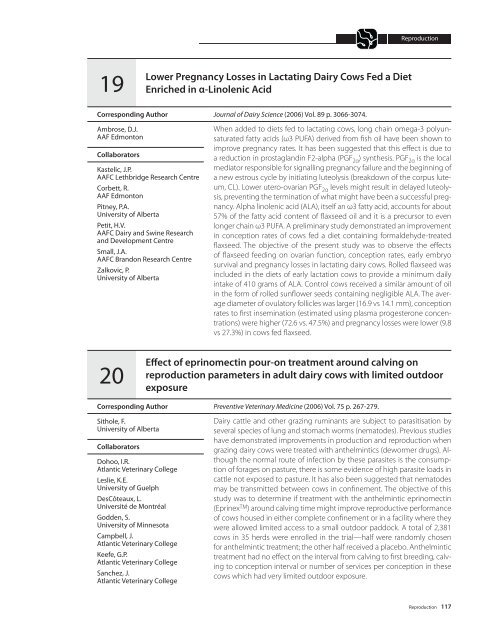A52-75-2007E.pdf - AgroMedia International Inc
A52-75-2007E.pdf - AgroMedia International Inc
A52-75-2007E.pdf - AgroMedia International Inc
Create successful ePaper yourself
Turn your PDF publications into a flip-book with our unique Google optimized e-Paper software.
Reproduction19Lower Pregnancy Losses in Lactating Dairy Cows Fed a DietEnriched in α-Linolenic AcidCorresponding AuthorAmbrose, D.J.AAF EdmontonCollaboratorsKastelic, J.P.AAFC Lethbridge Research CentreCorbett, R.AAF EdmontonPitney, P.A.University of AlbertaPetit, H.V.AAFC Dairy and Swine Researchand Development CentreSmall, J.A.AAFC Brandon Research CentreZalkovic, P.University of AlbertaJournal of Dairy Science (2006) Vol. 89 p. 3066-3074.When added to diets fed to lactating cows, long chain omega-3 polyunsaturatedfatty acids (ω3 PUFA) derived from fish oil have been shown toimprove pregnancy rates. It has been suggested that this effect is due toa reduction in prostaglandin F2-alpha (PGF 2α ) synthesis. PGF 2α is the localmediator responsible for signalling pregnancy failure and the beginning ofa new estrous cycle by initiating luteolysis (breakdown of the corpus luteum,CL). Lower utero-ovarian PGF 2α levels might result in delayed luteolysis,preventing the termination of what might have been a successful pregnancy.Alpha linolenic acid (ALA), itself an ω3 fatty acid, accounts for about57% of the fatty acid content of flaxseed oil and it is a precursor to evenlonger chain ω3 PUFA. A preliminary study demonstrated an improvementin conception rates of cows fed a diet containing formaldehyde-treatedflaxseed. The objective of the present study was to observe the effectsof flaxseed feeding on ovarian function, conception rates, early embryosurvival and pregnancy losses in lactating dairy cows. Rolled flaxseed wasincluded in the diets of early lactation cows to provide a minimum dailyintake of 410 grams of ALA. Control cows received a similar amount of oilin the form of rolled sunflower seeds containing negligible ALA. The averagediameter of ovulatory follicles was larger (16.9 vs 14.1 mm), conceptionrates to first insemination (estimated using plasma progesterone concentrations)were higher (72.6 vs. 47.5%) and pregnancy losses were lower (9.8vs 27.3%) in cows fed flaxseed.20Effect of eprinomectin pour-on treatment around calving onreproduction parameters in adult dairy cows with limited outdoorexposureCorresponding AuthorSithole, F.University of AlbertaCollaboratorsDohoo, I.R.Atlantic Veterinary CollegeLeslie, K.E.University of GuelphDesCôteaux, L.Université de MontréalGodden, S.University of MinnesotaCampbell, J.Atlantic Veterinary CollegeKeefe, G.P.Atlantic Veterinary CollegeSanchez, J.Atlantic Veterinary CollegePreventive Veterinary Medicine (2006) Vol. <strong>75</strong> p. 267-279.Dairy cattle and other grazing ruminants are subject to parasitisation byseveral species of lung and stomach worms (nematodes). Previous studieshave demonstrated improvements in production and reproduction whengrazing dairy cows were treated with anthelmintics (dewormer drugs). Althoughthe normal route of infection by these parasites is the consumptionof forages on pasture, there is some evidence of high parasite loads incattle not exposed to pasture. It has also been suggested that nematodesmay be transmitted between cows in confinement. The objective of thisstudy was to determine if treatment with the anthelmintic eprinomectin(Eprinex TM ) around calving time might improve reproductive performanceof cows housed in either complete confinement or in a facility where theywere allowed limited access to a small outdoor paddock. A total of 2,381cows in 35 herds were enrolled in the trial—half were randomly chosenfor anthelmintic treatment; the other half received a placebo. Anthelmintictreatment had no effect on the interval from calving to first breeding, calvingto conception interval or number of services per conception in thesecows which had very limited outdoor exposure.Reproduction 117





